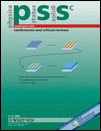Photoluminescence mapping of p-to-n conversion in CdTe by annealing in Cd atmosphere
Abstract
The p-to-n conversion of CdTe single crystals caused by low temperature annealing in cadmium atmosphere is investigated by photoluminescence (PL), electron beam induced current method (EBIC) and galvanomagnetic measurements. We show that PL of excitons bound to silver, copper and sodium neutral acceptors in the converted n-type exhibits drastic reduction (about three orders of magnitude) comparing to unconverted p-type or as grown crystal. Simultaneously, we observe that cadmium substitutional acceptors diffuse fast interstitially into remaining p-type, where they recombine with Cd vacancies and accumulate in the sample core. Concentration of donors is only slightly modified. This effect has a potential application in preparation of pure n-type CdTe samples. (© 2005 WILEY-VCH Verlag GmbH & Co. KGaA, Weinheim)




